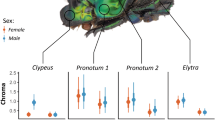Summary
Variations in the begging behaviour of the nestlings of altricial birds can provide the parents with information about the nestlings' nutritional needs and thus influence the parental feeding rate. In a series of four experiments, the stimulus situation encountered by great tits on their feeding visits to the brood was manipulated to explore its effect on feeding rate.
A higher feeding rate was observed under the following conditions: (1) after a period of food deprivation, as compared with both normal conditions and satiation through artificial feeding; (2) in periods when recorded begging calls were played during feeding visits, as compared with control periods; (3) after temporary removal from the nest of heavier, as compared with lighter, siblings. The lighter nestlings in the brood benefitted more —in terms of gain in weight — from the increase in parental feeding rate following the playing of begging calls than did the heavier nestlings. Differences in weight spread within broods did not affect the amount of food the parents brought.
We conclude that parental feeding rate is affected not simply by the begging of the hungriest nestling, but rather by the behaviour of all the nestlings in the brood, which makes possible an adjustment of the feeding rate to the average hunger level of the brood. The effects of hatching asynchrony and sibling competition on parental feeding rate are discussed.
Similar content being viewed by others
References
Andrew RJ (1957) A comparative study of the calls of Emberiza spp. Ibis 99:27–42
Balen JH van (1973) A comparative study of the breeding ecology of the great tit Parus major in different habitats. Ardea 61:1–93
Balph MH (1975) Development of young Brewer's blackbirds. Wilson Bull 87:207–230
Bengtsson H, Rydén O (1981) Development of parent-young interaction in asynchronously hatched broods of altricial birds. Z Tierpsychol 56:255–272
Best LB (1977) Field sparrow nestling biology. Auk 94:308–319
Bryant DM (1978) Establishment of weight hierarchies in the broods of house martins Delichon urbica. Ibis 120:16–26
Clark AB, Wilson DS (1981) Avian breeding adaptations: Hatching asynchrony, brood reduction, and nest failure. Q Rev Biol 56:255–277
Dawkins R (1976) The selfish gene. Oxford University Press, Oxford
Dawkins R, Krebs JR (1978) Animal signals: Information or manipulation? In: Krebs JR, Davies NB (eds) Behavioural ecology. An evolutionary approach. Blackwell, Oxford, pp 282–309
Drent RH, Daan S (1980) The prudent parent: energetic adjustments in avian breeding. Ardea 68:225–252
Gibb J (1950) The breeding biology of the great and blue titmice. Ibis 92:507–539
Haartman L von (1953) Was reizt den Trauerfliegenschnäpper (Muscicapa hypoleuca) zu füttern? Vogelwarte 16:157–164
Haartman L von (1954) Der Trauerfliegenschnäpper, III. Die Nahrungsbiologie. Acta Zool Fenn 83:1–96
Henderson BA (1975) Role of chick's begging behavior in the regulation of parental feeding behavior of Larus glaucescens. Condor 77:488–492
Howe HF (1976) Egg size, hatching asynchrony, sex, and brood reduction in the common grackle. Ecology 57:1195–1207
Howe HF (1978) Initial investment, clutch size, and brood reduction in the common grackle. Ecology 59:1109–1122
Hussell DJT (1972) Factors affecting clutch size in arctic passerines. Ecol Monogr 42:317–364
Keil W von (1967) Beiträge zur Ermittlung der Fütterungsfrequenz einiger Singvögel. Angew Ornithol 4:141–148
Khayutin SN, Dmitrieva LP (1976) On the interaction of food and defense reactions in nestling Muscicapa hypoleuca. Zool Zh 55:1046–1051 (in Russian with English summary)
Khayutin SN, Dmitrieva LP (1977) Behavioural mechanisms synchronizing the development of nestlings in the same clutch under their non-simultaneous hatching. Zool Zh 56:1195–1206 (in Russian with English summary)
Khayutin SN, Dmitrieva LP (1978) Formation of species-specific acoustic sensibility in hole nestlings. Zh Vyssh Nervn Deyat im IP Pavlova 28:621–627 (in Russian with English summary)
Khayutin SN, Dmitrieva LP (1979) Sensory organization of nest behaviour in Parus major (Aves). Zool Zh 58:1835–1847 (in Russian with English summary)
Kluyver HN (1950) Daily routines of the great tit, Parus major L. Ardea 38:99–135
Kluyver HN (1961) Food consumption in relation to habitat in breeding chikadees. Auk 78:532–550
Lack D (1956) Swifts in a tower. Methuen, London
Lack D (1968) Ecological adaptations for breeding in birds. Methuen, London
Löhrl LB (1968) Das Nesthäkchen als biologisches Problem. J Ornithol 109:383–395
Muller RE, Smith DG (1978) Parent-offspring interactions in zebra finches. Auk 95:485–495
Neub M (1979) Brutbiologische Konsequenzen des asynchronen Schlüpfens bei Kohlmeise (Parus major) und Blaumeise (Parus caeruleus). J Ornithol 120:196–214
Nuechterlein GC (1981) Asynchronous hatching and sibling competition in western grebes. Can J Zool 59:994–998
O'Connor RJ (1975) Initial size and subsequent growth in passerine nestlings. Bird-Banding 46:329–340
O'Connor RJ (1978) Brood reduction in birds: selection for fratricide, infanticide and suicide? Anim Behav 26:79–96
Perrins CM (1965) Population fluctuations and elutch-size in the great tit, Parus major L. J Anim Ecol 34:601–647
Royama T (1966) Factors governing feeding rate, food requirement and brood size of nestling great tits Parus major. Ibis 108:313–347
Rydén O (1978) Egg weight in relation to laying sequence in a South Swedish urban population of the blackbird Turdus merula. Ornis Scand 9:172–177
Rydén O (1982) Selective resistance to approach: a precursor to fear responses to an alarm call in the great tit Parus major. Dev Psychobiol 15:113–120
Rydén O, Bengtsson H (1980) Differential and locomotory behavior by early and late hatched nestlings affecting the distribution of food in asynchronously hatched broods of altricial birds. Z Tierpsychol 53:209–224
Schifferli L (1973) The effect of egg weight on subsequent growth of nestling Great Tits Parus major. Ibis 115:549–558
Stierhof H (1963) Ein Versuch zur differenzierten Fütterungs-frequenzmessung bei Kohlmeise (Parus major) und Trauerschnäpper (Ficedula hypoleuca). Angew Ornithol 1:164–172
Tinbergen JM (1981) Foraging decisions in starlings (Sturnus vulgaris L.). Ardea 69:1–67
Trivers RL (1974) Parent-offspring conflict. Am Zool 14:249–264
Werschkul DF (1979) Nestling mortality and the adaptive significance of early locomotion in the little blue heron. Auk 96:116–130
Author information
Authors and Affiliations
Rights and permissions
About this article
Cite this article
Bengtsson, H., Rydén, O. Parental feeding rate in relation to begging behavior in asynchronously hatched broods of the great tit Parus major . Behav Ecol Sociobiol 12, 243–251 (1983). https://doi.org/10.1007/BF00290777
Received:
Accepted:
Issue Date:
DOI: https://doi.org/10.1007/BF00290777




